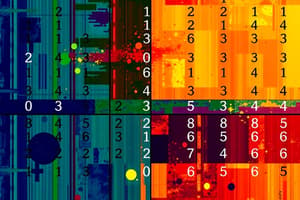Podcast
Questions and Answers
What type of matrix has the same number of rows and columns?
What type of matrix has the same number of rows and columns?
- Column matrix
- Row matrix
- Rectangular matrix
- Square matrix (correct)
What is the result when a matrix is multiplied by a scalar?
What is the result when a matrix is multiplied by a scalar?
- The determinant of the matrix
- A different matrix with elements multiplied by the scalar (correct)
- An identity matrix
- The sum of all elements of the matrix
Which type of matrix has all non-diagonal elements as zero?
Which type of matrix has all non-diagonal elements as zero?
- Identity matrix
- Diagonal matrix (correct)
- Skew symmetric matrix
- Symmetric matrix
What is the characteristic feature of an upper triangular matrix?
What is the characteristic feature of an upper triangular matrix?
Which property characterizes a singular matrix?
Which property characterizes a singular matrix?
Flashcards are hidden until you start studying
Study Notes
Square Matrix
- A square matrix has the same number of rows and columns.
Scalar Multiplication of a Matrix
- Multiplying a matrix by a scalar involves multiplying each element of the matrix by that scalar.
Diagonal Matrix
- A diagonal matrix has all its non-diagonal elements equal to zero.
Upper Triangular Matrix
- An upper triangular matrix has all elements below the main diagonal equal to zero.
Singular Matrix
- A singular matrix has a determinant equal to zero.
Studying That Suits You
Use AI to generate personalized quizzes and flashcards to suit your learning preferences.




